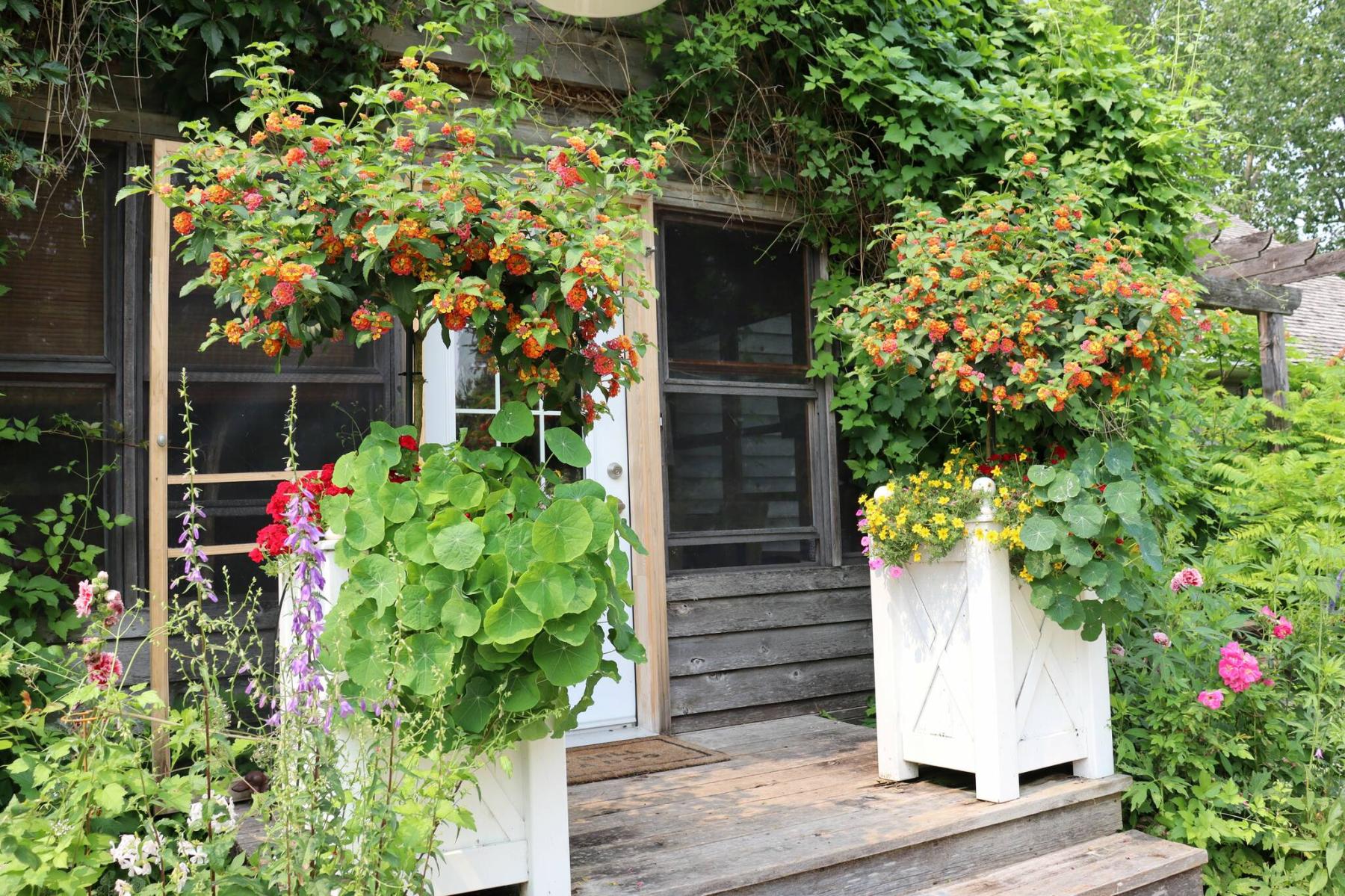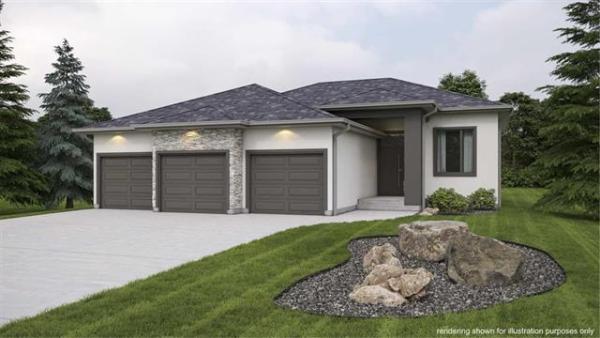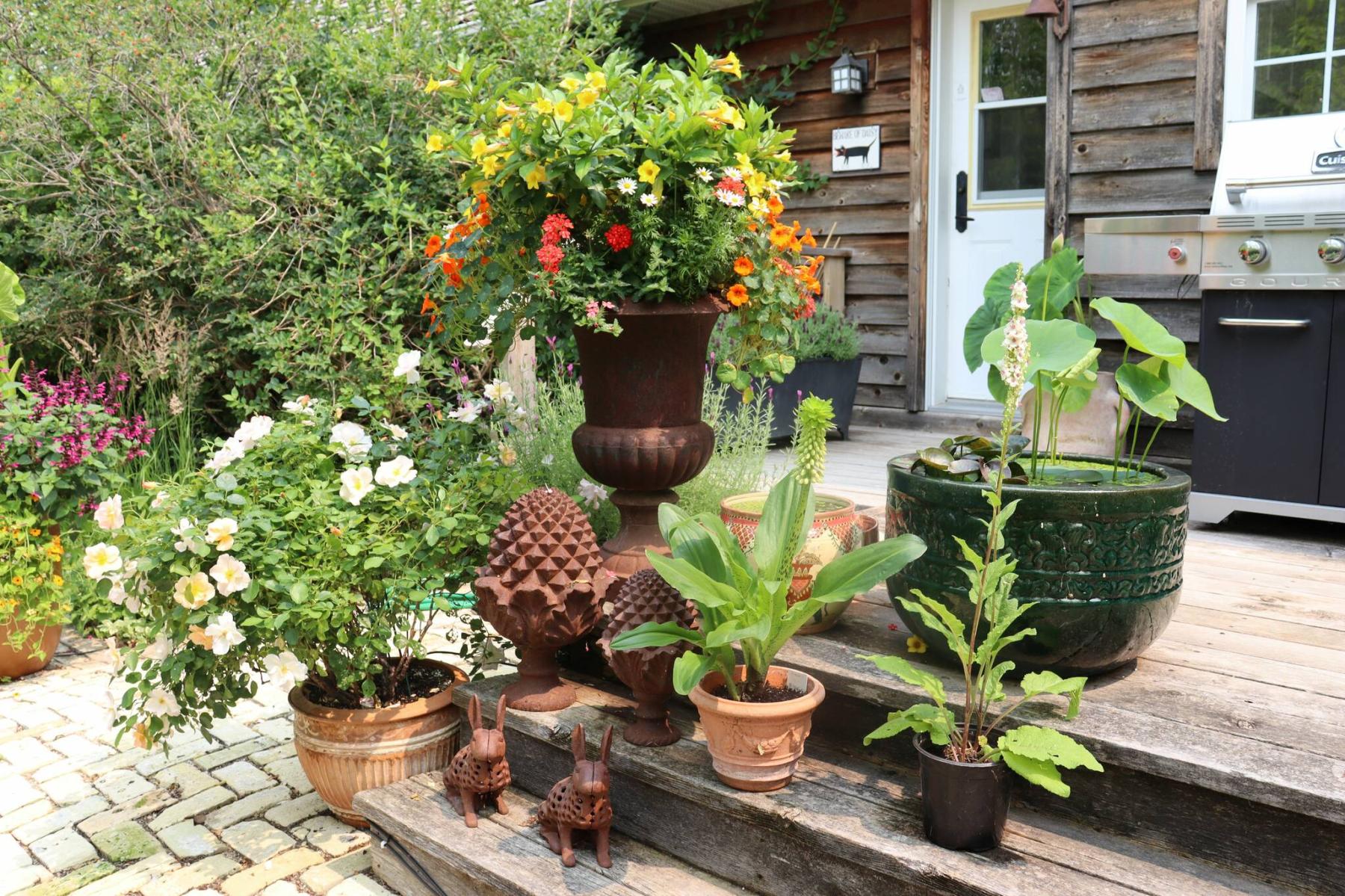
Iron with a rusty patina brings a vintage vibe to this container grouping that includes decorative acorn finials and rabbit decor.
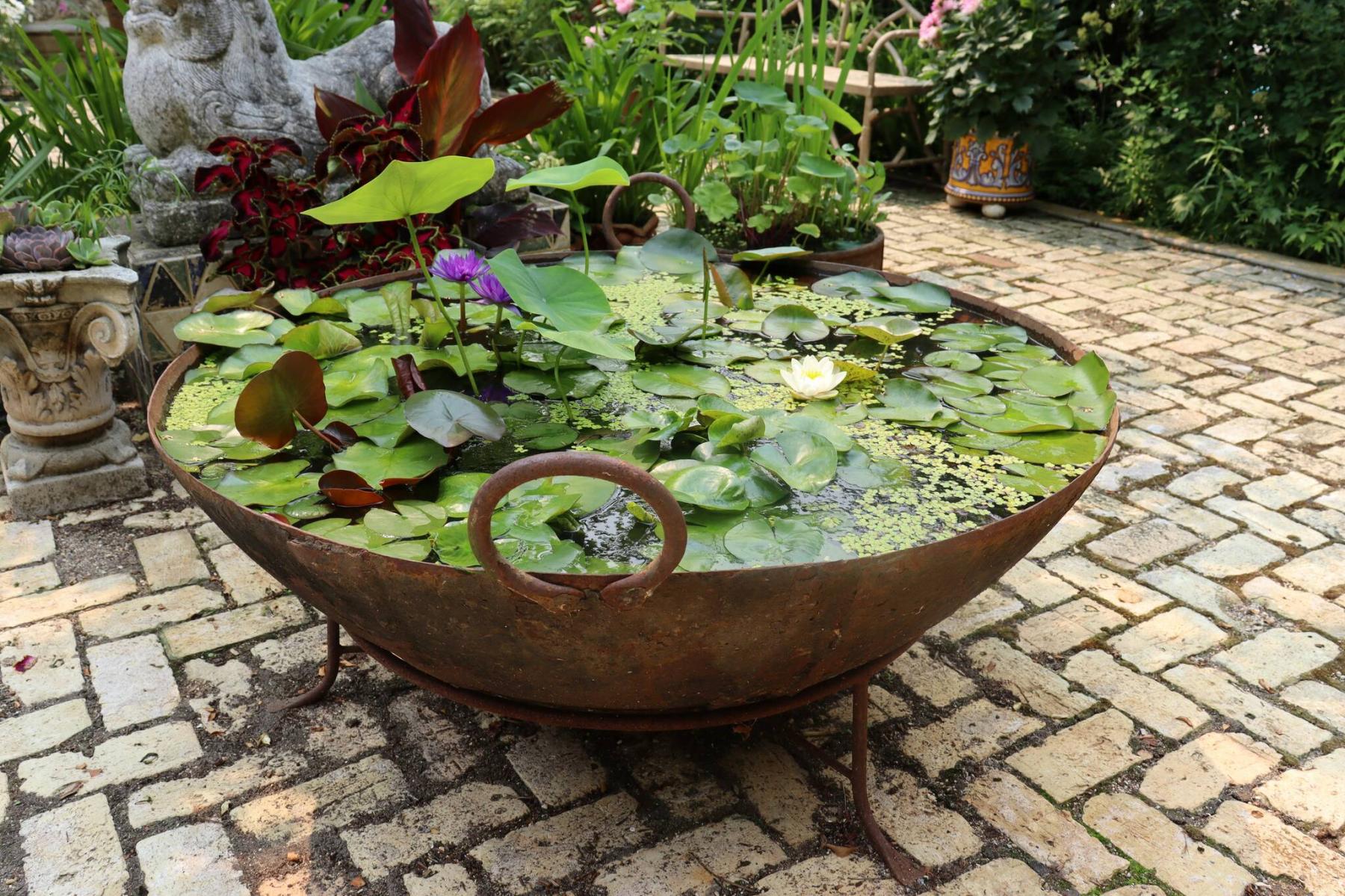
Piece de resistance: This vintage iron cooking vessel, 120 cm in diameter, is transformed into a water garden with water lilies and lotus.
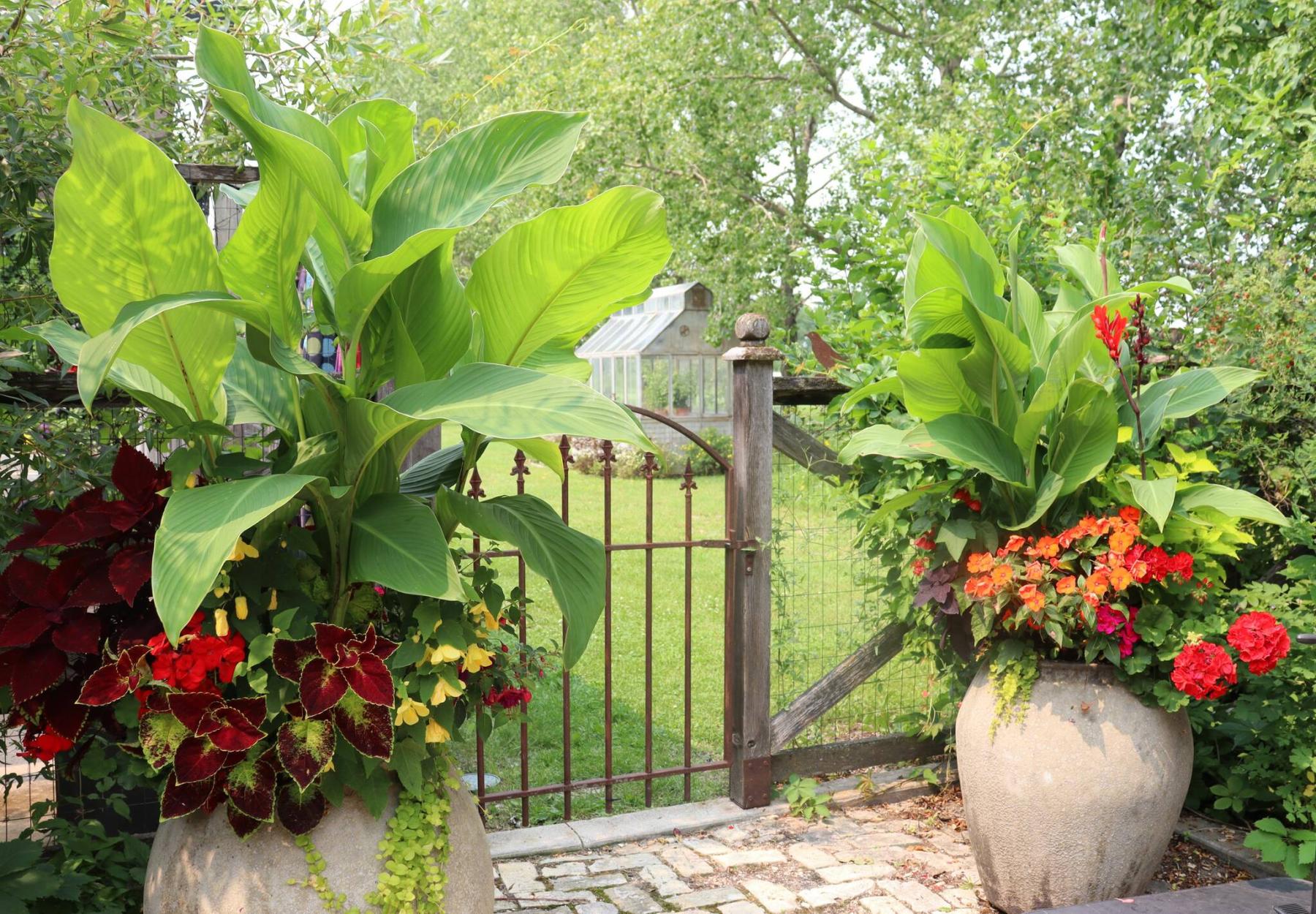
Stoneware planters with canna lilies that have recovered from earlier hail damage, flank an antique iron gate.
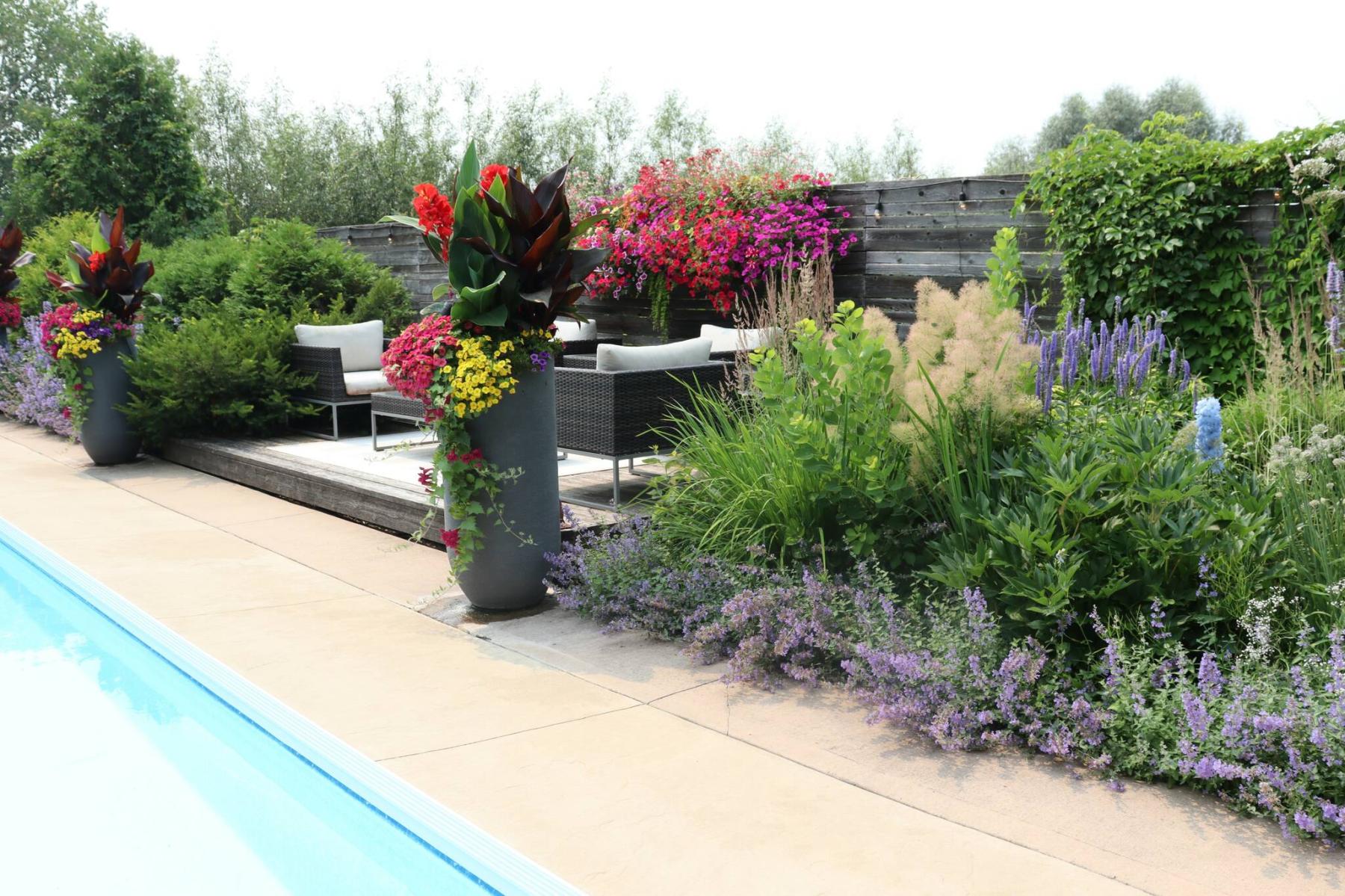
Tall poolside containers with canna lilies stand out in this contemporary garden with lushly planted linear borders.
John Tinkler’s vision for his private garden, a richly planted acreage located on the outskirts of Winnipeg, is compelling. Inspired forms, colours, and textures compliment his three distinct garden rooms – cottage garden, courtyard garden, and contemporary garden.
In each of these garden rooms, Tinkler has created a breathtaking display of flowers and foliage that abundantly fill his landscape’s curved or linear borders. But at every turn, along every path, and through each vintage iron or weathered cedar gate, Tinkler’s passion for design heightens the senses. His skillful use of container gardens, vertical accents, evocative pottery and objets d’art combined with his ability to arrange each décor element in artful groupings creates beautiful gardens within gardens.
“Shocking beauty” was Tinkler’s answer when I asked him what it is that he strives for when designing plant combinations and groupings for his containers. “I have read Thomas Hobbs’ book, Shocking Beauty, and I keep that phrase in my head when I am creating my container displays,” said Tinkler.
In his book, Shocking Beauty, (Raincoast Books, 1999), Thomas Hobbs writes about the too rare experience of being overwhelmed by what we see. He writes, “When it hits me, I try to drink in the moment, standing absolutely still and practicing ‘freeze frame’ with my eyes and mind.” Beauty has an impact on all our senses and like Hobbs who is a master at staging a scene – or incident as he prefers to describe it — Tinkler creates staggeringly beautiful garden scenes where plants are a major player but with a strong supporting cast of elegant structures and materials. Creative placement is everything.
The co-owner of Design Manitoba which opened its doors in Winnipeg in 1977, Tinkler likes to collect things. His one criterion is that whatever he collects must be authentic, whether the style is contemporary, antique or vintage. As the buyer for Design Manitoba, he travels extensively.
Does he know in advance when something catches his eye how he will use it in his garden? “No, not necessarily,” said Tinkler. “I always have a supply of containers ready to go when I need to plan or plant something, but they have to be unique. A lot of them are very classic so if they are terra cotta, they are aged and weathered and they look like a vintage piece whether they are or not. No plastic.”
Iron with a rusty patina has a special appeal. Awaiting placement in one of his garden spaces are two-metre tall, rusted iron columns with finials. “They don’t really have a home yet but whenever I find anything interesting, I just buy it and I know I will find a home for it.”
Height is an essential component in Tinkler’s imaginative designs. He may well be utilizing the thriller, filler, spiller design technique that is considered de rigueur when creating container arrangements but his design effect is like a delicious cake with multiple layers. A feast for the eyes.
In the cottage garden near a front entranceway clad in weathered cedar with a white painted door, stand two orange and yellow-flowered Lantana topiary trees in classic white Versailles planter boxes. The topiaries have been underplanted with a broad skirt of nasturtium. “I can’t always find lantana topiaries but when I do, they are the best plant for the Versailles boxes. They have that great lollipop shape and great colour all season. The Versailles boxes are very suitable for the style of the house which is Cape Cod on the outside and English country farmhouse on the inside.”
Beneath a nearby window framed with green shutters, is a long wooden window box, painted white, densely planted with annuals that include colourful petunias, white begonias, variegated ivy, chartreuse sweet potato vine, and nasturtium. Next year, though, Tinkler plans to switch out nasturtium and sweet potato vine for trailing vines such as Rudbeckia hirta black-eyed Susan. “Around the beginning of August, nasturtium and sweet potato vine get eaten by flea beetles.”
He also plans to make greater use of coleus in his planters. “For years coleus was just a shade plant but now many of the varieties are also reliably sun tolerant. Who knew? And the foliage is beautiful, so you are getting this amazing colour without having to wait for flowers.” Coleus features in several of his container designs. Favourite varieties include Inferno, Electric Lime, and Pink Chaos.
Containers are used throughout the spacious courtyard garden which is surfaced entirely with reclaimed brick. In a shady corner is a white planter box with a large philodendron which Tinkler has combined with white and yellow begonias. A hailstorm in early June stripped the philodendron, a long-held houseplant, of its deeply cut foliage. It has since fully recovered, and Tinkler will bring it indoors in the fall for the winter. Banana plants and canna lilies are a mainstay in his container garden designs and decorate numerous planters in the courtyard and contemporary poolside garden. The huge leaves of these tropical plants were also ravaged by the late spring hailstorm but now, in midsummer, they are radiant and healthy.
A pair of stoneware planters flank an antique iron gate which leads to a cottage greenhouse with a Victorian aesthetic. Each planter includes multiple canna lilies with large, glossy leaves. “With the planter, they stood six feet high, but the hail stripped off all the leaves. I cut them back and they sent up all new growth.”
English garden roses – Boscobel David Austin rose with fully double clusters of cupped pink rosettes and Sweet Mademoiselle, a hybrid tea rose with pink and peach tones – are showcased in containers as well. “Roses work very well in containers because containers bring them up higher so that you can see them and smell their fragrance.”
A potted rose sits at the edge of a vignette on the steps of the weathered cedar deck that faces into the courtyard. An elegant cast iron urn with a vivid arrangement of yellow, orange, and pink flowering annuals provides the highest point. Next to it is a miniature water lily garden in a dark green ceramic planter. Accents include vintage iron acorn finials and the most amazing, rusted iron rabbits. “Those came from Design Manitoba,” he said. “I wasn’t buying them for myself at the time but when they arrived, I knew they were coming home with me.”
The piece de resistance, though, sits nearby on the cobblestoned courtyard: an elegantly footed, water-filled iron vessel, 1.2 metres in diameter, with water lilies and lotus floating on the surface. “It’s an enormous cooking vessel from India,” said Tinkler.
In another vignette, a pair of carved cedar chairs sit opposite a vintage wood and iron potting bench which holds two oleander plants in different containers together with an assortment of smaller, empty pottery and collectibles. Tinkler does not aim for a mirror image. A sense of harmonious and beautiful proportion prevails, nonetheless.
If gardens are about vision and ideas and creating an outdoor space that is extraordinary and memorable, then Tinkler’s garden is the work of a gardener at the top of his game.
colleenizacharias@gmail.com

